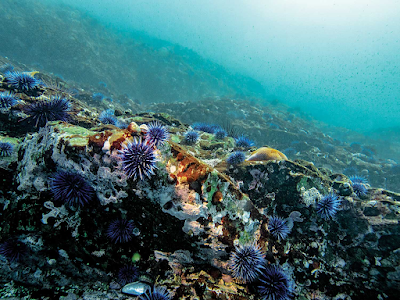Sea Urchins in the Mediterranean Sea can Withstand Hot, Acidic Seas
In bubbling vents off the coast of Ischia, a volcanic island in the Gulf of Naples lives a curious population of black sea urchins. For at least 30 years, they have lived in these low pH, carbon dioxide-rich environments -- a proxy for climate change-induced acidic oceans.
Now, University of Sydney researchers have determined they can also tolerate unprecedentedly warm sea temperatures -- another climate change by-product. This means that these urchins, already one of the most abundant animals in the Mediterranean Sea, will likely plunder further afield as oceans continue to warm and become more acidic.
The researchers have described their findings in Biology Letters, a publication of the Royal Society.
The Mediterranean Sea is warming 20 percent faster than the global average, with predicted warming of up to 5.8°C by 2100.
"Given their ability to withstand a large temperature range, these sea urchins are likely to continue spreading throughout the Mediterranean Sea, with serious consequences for coastal habitats," said lead researcher, University of Sydney marine biologist Dr. Shawna Foo.
When urchin numbers swell disproportionately, they ravage kelp forests and algae -- a food source -- causing the demise of other species that rely on kelp for food or shelter. What's left -- a rocky, sandy, urchin-filled seafloor -- is known as an 'urchin barren'.
Worldwide, including on the east coast of Australia and the coastline stretching Nova Scotia to Chile, urchin barrens continually grow. Much of this can be attributed to rising sea temperatures assisting the expansion of sea urchin populations, as the water becomes warm enough for their offspring to survive.
Along Australia's southeast, for example, the long-spined sea urchin has multiplied and trekked south as climate change-strengthened currents warm the seas. Once localized to New South Wales, they can now be found in Tasmania, overgrazing kelp, with negative impacts on abalone and lobster farms.
Discovering that urchins are zen
Despite not practicing mindfulness or intentionally exercising, it's hard to make a black sea urchin stressed. The researchers discovered this when testing their heat tolerance. They exposed lab-fertilized embryos from populations of urchins living in and outside the CO2 vents to a wide temperature range: between 16 and 34°C. The water around Ischia is typically 24°C.
Not only did they have a similar maximum heat tolerance; 24-hour-old embryos from the low pH-acclimated urchins (from the vents) could withstand a greater temperature range than ones living in normal pH -- a 12.3°C versus 5.4°C range.
"We didn't know if acclimating to one stress -- high CO2 levels -- would mean the urchins would be more susceptible to other stressors, such as warming," Dr. Foo said. "You could compare it to humans not performing as well at work when they're really stressed out. Yet our results show that living in a low pH environment didn't create any trade-offs."
Only at 32°C did both types of embryos suffer due to the heat, with more abnormal development than would be seen in a general urchin population. The Mediterranean Sea is only predicted to reach temperatures this high in the peak of summer in around 30 years -- by 2050.
On the bright side, however, Dr. Foo says the vent urchins' superpower survival abilities may offer insights into adaptations other animals might need to survive as the oceans warm and become more acidic, for example, by determining the genes responsible for their high-stress tolerance.
"We're lucky to have the opportunity to work in such a unique system with low pH-acclimated animals," Dr. Foo said. "They give us a glimpse into the state of organisms and ecosystems in a future ocean."




Comments